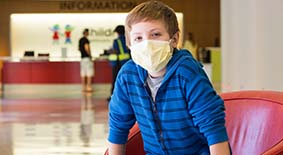What Is Arthritis in Children?
Juvenile idiopathic arthritis (JIA) is the most common type of arthritis that affects children before the age of 16. JIA occurs when your child’s immune system is not working properly, and the body attacks the joints. Characterized by swelling, pain, stiffness and warmth of an affected joint, chronic arthritis in your child that lasts more than six weeks is most commonly due to JIA.
Rheumatologists do not know the exact cause of JIA, but research has shown that it is the result of an interaction between certain genes and an unknown trigger in the environment. The immune system becomes overactive and attacks the body, which results in joint inflammation in patients with JIA.

JIA is a more widely used term because it includes a broader spectrum of children with different features, but these patients share the presence of arthritis as a feature of their disease.
There are seven subtypes of JIA:
- Oligoarticular: This is the most common subtype of JIA. This subtype affects four or fewer joints, typically the larger ones such as knees, ankles and elbows.
- Systemic: This subtype affects about 10% of children and presents with a fever of 103°F or higher accompanied by a skin rash. It affects the entire body.
- Rheumatoid factor positive polyarticular: Patients with this subtype of JIA have arthritis in five or more joints, and have a blood marker called rheumatoid factor.
- Rheumatoid factor negative polyarticular: This subtype also involves five or more joints, but these patients are negative when tested for the presence of rheumatoid factor in their blood.
- Enthesitis-related: This subtype is more common in boys and appears between the ages of eight and 15. It affects muscles, ligaments or tendons that attach to the bone in areas such as the hips, knees and feet.
- Psoriatic: This subtype commonly affects one or more joints, most often the wrists, knees, ankles, fingers and toes. A scaly rash may also appear behind the ears or on the eyelids, knees, elbows, belly button or scalp.
- Undifferentiated: Inflammation is present in one or more joints, but symptoms of this subtype don’t match up perfectly with any of the above subtypes.
“We favor the use of the term juvenile idiopathic arthritis instead of rheumatoid arthritis when used in children. Juvenile rheumatoid arthritis usually refers to polyarticular JIA, as these patients’ symptoms are similar to those seen in adults with rheumatoid arthritis,” explains Kelly Rouster-Stevens, MD, pediatric rheumatologist at Children’s. “However, juvenile arthritis—or JIA—should not be used interchangeably with rheumatoid arthritis.”
Children can develop symptoms that mirror those of adults with rheumatoid arthritis, specifically children with polyarticular JIA. But the symptoms of arthritis in kids can vary and depend on your child’s JIA subtype. Our specialists typically see the following symptoms in children:
- Swelling and warmth of the affected joint
- Pain that is usually worse after prolonged periods of inactivity (such as in the early morning or after a nap)
- Limping
- Decreased ability to use the affected joint
Other possible symptoms that your child might experience include:
- Fatigue
- Poor weight gain
- Slow growth due to chronic inflammation
“Unlike adults with rheumatoid arthritis, patients with JIA tend to develop eye inflammation and should have periodic eye checks by an ophthalmologist,” says Dr. Rouster-Stevens.
If your child is diagnosed with systemic JIA, they may experience other symptoms including rash, swollen lymph nodes, and a fever.
There are medications that can be used to help treat arthritis, but treatment depends on your child’s subtype, as well as the number and location of the affected joints. Medications and treatments can include:
- Non-steroidal anti-inflammatory medications (such as ibuprofen, naproxen)
- Steroids (either by injection or by mouth)
- Disease-modifying antirheumatic drugs (also known as DMARDs, such as methotrexate)
- Biologic medications (such as adalimumab, etanercept, infliximab)
Physical therapy, occupational therapy and regular eye checks are also an integral part of the treatment of JIA.
“Treating JIA will not only help relieve joint pain and swelling, but also help prevent permanent damage to the growing bones,” says Dr. Rouster-Stevens.
Your child may achieve remission with the use of medication. Some children with JIA will be able to get off medications once they enter remission, but there are also children who require treatment into adulthood. Your child’s arthritis outcome depends on the subtype of JIA that they have, as well as the severity of their disease, and their response to treatment.
“You have to have patience,” says Shaveda, whose 16-year-old daughter Kimora has been treated at Children’s since she was first diagnosed with JIA at 10 months old. “This is something that none of us have control over, but the doctors at Children’s know what they are doing. You can trust their experience.”
Kimora, a high school student and avid dancer, also has some advice for other kids experiencing JIA. “It’s a very emotional and mental thing to go through,” she says. “You can be OK with the things you can’t control, and use your disability as a blessing or an advantage.”
This content is general information and is not specific medical advice. Always consult with a doctor or healthcare provider if you have any questions or concerns about the health of a child. In case of an urgent concern or emergency, call 911 or go to the nearest emergency department right away. Some physicians and affiliated healthcare professionals on the Children’s Healthcare of Atlanta team are independent providers and are not our employees.
Contact Us 404-785-KIDS (5437)


